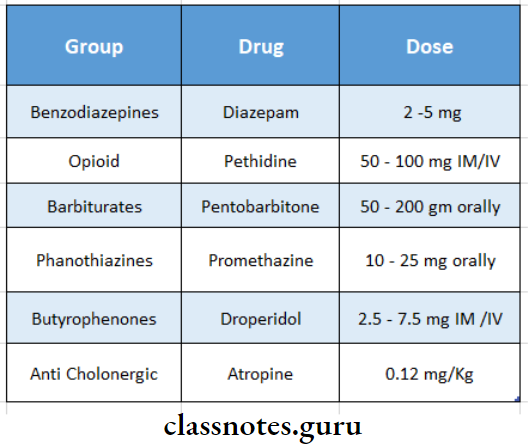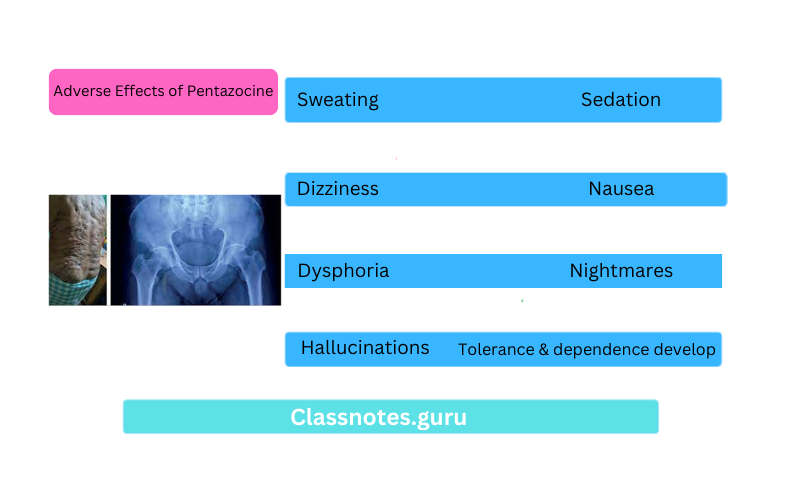General Anaesthesia And Sedation In Oral And Maxillofacial Surgery Important Notes
1. Agents:

2. Different Concentrations Of Nitrous Oxide N2O:
Read And Learn More: Oral and Maxillofacial Surgery Question and Answers

3. Nitrous Oxide
- Also called laughing gas
- Name given by Humphry Davy
- First prepared by Joseph Priestly in 1774
Nitrous Oxide Properties:
- Used as carrier gas
- The maximum concentration of nitrous oxide which can be given is 66%
- The blood gas coefficient is 0.47
- It is non-inflammable, non-explosive
- Good analgesia
- Not a muscle relaxant
General Anaesthesia And Sedation In Oral And Maxillofacial Surgery Short Essays
Questions 1. Preanaesthetic evaluation.
Answer:
Preanaesthetic Need:
- To get an idea about the patient’s health
- To educate the patient
- To obtain consent
Preanaesthetic Evaluation:
- Patient’s medical history
- Allergies to any drugs
- Deleterious habits
- Anaesthetic problems
- The general health of the patient
- CVS system
- Respiratory system
- Hepatic system
- GIT system
- Renal system
- Endocrine system
- Haematological examination
- Reproductive system
- Vital signs
Questions 2. Premedication
(or)
Preanaesthetic medication
Answer:
Premedication
- Objectives
- Reduces anxiety
- Analgesia
- Amnesia
- Antiemetic
- Anti sialogogue
- Sedation
- Reduction of acidity
- Prophylactic
Premedication Drugs:

Question 3. IV Sedation
Answer:
Advantages Of IV Sedation:
- Effective
- Rapid onset
- Control of secretion
- Less emetic
- Diminished gag reflex
- Diminished motor disturbances
Disadvantages Of IV Sedation:
- Monitoring required
- Delayed recovery
Drugs Used:
- Diazepam-2-5 mg
- Ketamine-1-2 mg/kg IV
- Promethazine25 mg
- Pethidine – 50 mg
Questions 4. Indications & complications of GA.
Or
Indications of GA
Or
Complications of GA
Answer:
Indications Of GA:
- Extensive restoration along with extraction
- In young patients
- Uncooperative patients
- Acute infections
- Allergy to LA
- Failure to LA
- Failure to achieve sedation
Complications Of GA:
- Common Complications:
- Coughing
- Hiccups
- Wheezing
- Cyanosis
- Cardiac arrhythmia
- Laryngospasm
- Complications: Due To Position:
- Nerve injury
- Air embolism
Post-Operative Complication:
- Nausea & vomiting
- Hypertension
- Infection
- Restlessness
- Shivering
- Respiratory obstruction
General Anaesthesia And Sedation In Oral And Maxillofacial Surgery Short Question And Answers
Questions 1. Infiltration anaesthesia.
Answer:
Infiltration Anaesthesia
- Infiltration Anaesthesia is a method of local anaesthesia
- Injection of a local anaesthetic solution directly into the tissue can be
- Superficial-only into the skin or
- Deep into deeper structures
- Duration can be doubled by adrenaline 1:200000
- Adrenaline should not be used
- Around end arteries to avoid necrosis
- Intra-cutaneously to avoid sloughing
- Infiltration Anaesthesia Drugs used:
- Lignocaine
- Procaine
- Bupivacaine
- Lignocaine
Advantages Of Infiltration Anaesthesia:
- Provide anaesthesia without disrupting normal bodily functions
Disadvantages Of Infiltration Anaesthesia:
- Systemic toxicity may occur in major surgeries
Uses Of Infiltration Anaesthesia:
- For minor procedures like incisions, drainage of an abscess, excision etc
Question 2. Role of muscle relaxants in General Anaesthesia
Answer:
Role Of Muscle Relaxants In General Anaesthesia
- Creates laryngeal relaxation
- Enables intubation
- Stops spontaneous breathing so the patient must be ventilated till the effect of anaesthesia
Role Of Muscle Relaxants In General Anaesthesia Drugs Include:
- Suxamethonium:
- Short-acting
- Rapid recovery
- Pancuronium:
- Non-depolarizing
- Siow onset of action
- Long-lasting effect
- Effect is reversible
Questions 3. Assessment for general anaesthesia.
Answer:
Assessment For General Anaesthesia
By the American Society of Anaesthesiologists ASA.
- ASA 1:
- No disturbances either systemic or physiological
- ASA 2:
- Mild to moderate systemic disturbances
- Can be treated surgically
- Mild organic heart disese, diabetes, hypertension, anaemia, old age
- ASA 3:
- Severe systemic disturbances Angina, MI, diabetes, etc
- ASA 4:
- Life-threatening severe systemic disturbances
- ASA 5:
- Patients not expected to survive for more than 24 hours
- ASA 6:
- Emergency
Questions 4. Prilocaine.
Answer:
Prilocaine
- Group: Amide
- Potency: 2
- Metabolism: Hydrolyzes by hepatic enzymes
- pka: 7.9
- pH of Plain Solution: 4.5
- pH of Vasoconstrictor: 3-4
- Plasma Half-Life: 1.6 hours
- Effective Dental Concentration: 4%
- Maximum Recommended Dose: 6 mg/kg body weight
Questions 5. Pentazocine.
Answer:
Pentazocine
Pentazocine is a k receptor agonist
Advantages Of Pentazocine:
- Less respiratory depressant
- Euphoria is seen in only low doses
Disadvantages Of Pentazocine:
- Weak antagonist
- Increases BP & heart rate
- Increases cardiac load
- Dose: 50-100 mg orally
Adverse Effects Of Pentazocine:
- Sweating
- Sedation
- Dizziness
- Nausea
- Dysphoria
- Nightmares
- Hallucinations
- Tolerance & dependence develop

Uses Of Pentazocine:
- Postoperative & chronic pain
Questions 6. Stages of general anaesthesia.
Answer:
Stages Of General Anaesthesia
- Stage Of Analgesia:
- From the beginning of inhalation of the anaesthetic to loss of consciousness
- Stage Of Delirium:
- From the loss of consciousness to the beginning of surgical anaesthesia
- Associated with excitement
- Stage Of Surgical Anaesthesia:
- Respiratory depression is seen
- Gradual loss of reflexes
- Relaxation of skeletal muscles
- Stage Of Medullary Paralysis:
- Seen in overdoses
- Medullary depression
- Cessation of breathing
- Circulatory failure
- Death may follow
Questions 7. Ketamine.
Answer:
Causes Of Ketamine:
- Dissociative anaesthesia:
- Intense analgesic
- Amnesia
- The feeling of dissociative from one’s own body & surroundings
Advantages Of Ketamine:
- Profound analgesic
- Doesn’t depress respiration
- Can be used in asthmatic patients
Disadvantages Of Ketamine:
- Hallucinations
- Dangerous in hypertensives
- Increases cerebral blood flow
- Increases intracranial pressure
Contraindications Of Ketamine:
- Hypertensive patients
- CCF
- Psychiatric disorders
- Pregnancy
Questions 8. Halothane.
Answer:
Halothane
- Colorless, volatile liquid with a sweet odour
- Non-irritant
- Non-inflammable
Advantages Of Halothane:
- Potent
- Rapid induction
- Rapid recovery
- Rarely causes post-operative nausea & vomiting
Disadvantages Of Halothane:
- Neither good analgesia nor good muscle relaxant Myocardial depressant
- Respiratory depressant
- Causes malignant hyperthermia
- Expensive
General Anaesthesia And Sedation In Oral And Maxillofacial Surgery Viva Voce
- Methohexital is the most commonly used drug for general anaesthesia
- The median cephalic vein is the optimum site for IV sedation
- The N:O gas cylinder used in general anaesthesia is blue coloured
- During general anaesthesia oxygen concentration of blood should not fall below 40%
- Nowadays induction phase of general anaesthesia has been reduced because of the use of thiopentone sodium
- If long-acting muscle relaxants are used during general anaesthesia their action is terminated by the use of neostigmine
- The most common postoperative complication of general anaesthesia is nausea
- The important sign a patient exhibits when the correct level of sedation is reached while using diazepam sedation is 50% ptosis of the eyelids
- Complete blood count and urinalysis should be done before the use of general anaesthesia
- Injection of contaminated alcohol can cause neurology- sis and may result in paraesthesia and permanent anaesthesia
- Minor surgeries are carried out in Stage 1
- Major surgeries are carried out in Stage 2
- Nitrous oxide is laughing gas
- The induction phase of general anaesthesia has been reduced nowadays due to the use of thiopentone sodium
- The N2O cylinder is blue
- During general anaesthesia oxygen concentration of blood should not fall below 40%
- Only nitrous oxide alone is not used as a general aesthetic agent due to difficulty in maintaining adequate oxygen concentration
- Behavioural problem is the most common complication associated with nitrous oxide sedation
